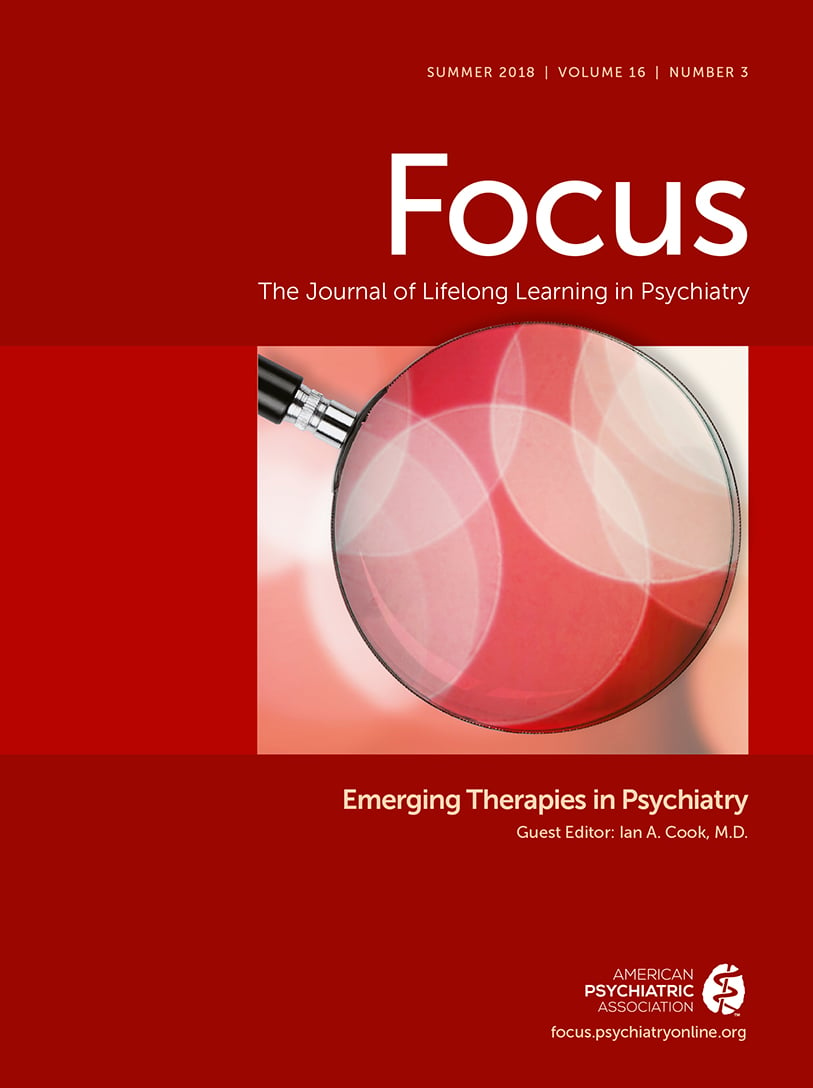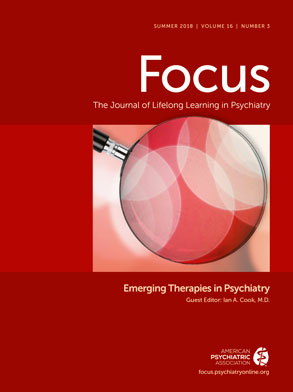Despite the retreat of many large pharmaceutical companies from research and development in the “CNS space,” recent years have seen the development of an array of new therapeutics for psychiatric patients, including new approaches to psychotherapy, new medications, and new neuromodulation methods. These innovations are all driven by unmet patient needs in efficacy, tolerability, treatment burden, and preference. As laboratory observation and theory are translated into clinically available therapeutics, keeping abreast of the current state of affairs in these innovative approaches can be daunting. In this issue of Focus, we have invited leaders in several areas to share their perspectives on emerging therapies.
The monoamine-based hypotheses of mood disorders that informed development of so many medications from the 1960s onward are now sharing the spotlight with theories based on other neurotransmitter systems. Theories involving glutamate and the brain’s response to chronic stress have been supported by in vitro, preclinical animal, and clinical human studies. In particular, agents that can influence glutamatergic neurotransmission via either the
N-methyl-
d-aspartate (NMDA) or the α-amino-3-hydroxy-5-methyl-4-isoxazolepropionic acid (AMPA) receptors have gained considerable attention. Early studies using the agent ketamine as a rapidly acting antidepressant for humans have gained traction in both clinical practice and in the development of alternative agents with similar effects. This work has captured the public’s attention as well, serving as a cover story for
Time magazine (
1). Sanacora and Katz (
2) review the theory behind ketamine and related medications for use in depression, highlight important elements of the pharmacology of ketamine, and synthesize the findings and limitations of human studies. Importantly, in an area where off-label clinical use of ketamine may outpace the research base, they have highlighted important risks, precautions, and holes in our collective knowledge as caveats for those interested in using glutamatergic treatments.
Developments in computer-related technologies have fueled the rise of virtual reality (VR) and augmented reality (AR) tools that can place a user in an immersive environment so that sight, sound, and vibrational cues all reinforce the experience that the user is in another place and time. Improvements in hardware and software have enabled the experience to become increasingly similar to real life, allowing the illusion to be much more real and powerful. While the entertainment and industrial application of VR and AR have gained public attention, their use as therapeutic tools has been growing in parallel. The article by Rizzo, Koenig, and Talbot (
3) describes the use of VR in posttraumatic stress disorder, especially the recreation of combat situations in which veterans with posttraumatic stress disorder (PTSD) experienced their traumas. The VR platform has been studied most extensively in that setting, but other traumatic experience environments, such as motor vehicle accidents, natural disasters, mass shootings, and other terrifying situations, could be adapted for treating PTSD in a wider civilian population. When coupled with artificial intelligence agents, VR could be expanded to therapeutic role-playing experiences with uses across a range of psychiatric conditions.
The growth of mobile computing also has taken on important uses in mental health. The application of digital technologies—frequently available anywhere at any time—have great potential to improve care, as Hirschtritt and Insel (
4) describe. Whether in developing improved diagnostic approaches, implementing measurement-based methods to evaluate response to treatment, or providing online forms of psychotherapy to patients when it is most convenient to them, there are many places where digital technology is likely to have increasing impact. Much as these technologies have transformed industries as diverse as retailing (e.g.,
Amazon.com), lodging (e.g., Airbnb), and transportation (e.g., Uber and Lyft), the possibility of large-scale transformation in health care generally, and mental health care in particular, is discussed with an eye to the impact on psychiatrists’ roles in a changing landscape.
With medication treatment, mechanisms of action are presumed to be tied to events happening primarily inside the brain. In contrast, other treatment approaches have sought to utilize alternative pathways to modulate brain-based events. Electrical stimulation of cranial nerves, such as vagus nerve stimulation, was shown in the mid-20th century to alter brain activity (
5) and more recently has been applied to clinical problems. A novel approach engages the interoceptive pathways that convey information to the brain about the internal state of the body and are represented at multiple locations in the brain. Lowry, Flux, and Raison (
6) review data supporting the possibility of altering CNS activity to treat depression by whole-body heating. Data from foundational neuroscience to randomized clinical trials lend support to using noninvasive activation of thermosensory pathways to produce clinical benefits.
One area not covered in this issue has to do with the neuromodulation methods that use electrical or magnetic fields to influence brain circuits toward therapeutic ends. The recent era in neuromodulation traces to the 1990s, with developments in repetitive transcranial magnetic stimulation (rTMS) and cranial nerve stimulation (e.g., of the vagus and now the trigeminal nerve). These are areas that have seen their own considerable growth, with over half a dozen new devices for rTMS and trigeminal nerve stimulation having been cleared by the Food and Drug Administration in the past decade. Because I am an inventor of methods and devices in this area, some of which have been licensed by University of California, Los Angeles, to commercial interests, this is a topic that will be covered in a future issue of Focus overseen by another guest editor.

